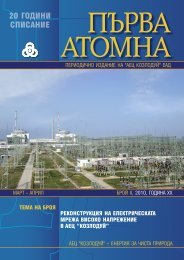Summary Report for Conduct of Kozloduy NPP Stress Tests
Summary Report for Conduct of Kozloduy NPP Stress Tests
Summary Report for Conduct of Kozloduy NPP Stress Tests
You also want an ePaper? Increase the reach of your titles
YUMPU automatically turns print PDFs into web optimized ePapers that Google loves.
“<strong>Kozloduy</strong> <strong>NPP</strong>” PLC<br />
SUMMARY REPORT<br />
<strong>for</strong> <strong>Conduct</strong> <strong>of</strong> <strong>Kozloduy</strong> <strong>NPP</strong><br />
<strong>Stress</strong> <strong>Tests</strong><br />
1.3.2.3.3 Availability <strong>of</strong> heat removal logics and measures to extend the systems operability<br />
The pumps, heat exchangers and the equipment <strong>of</strong> each channel <strong>of</strong> the SFP cooling system<br />
are located in a separate room, which provides physical separation and impossibility <strong>of</strong> simultaneous<br />
common cause failure <strong>of</strong> two or more channels. Each system is able to per<strong>for</strong>m its functions with<br />
account <strong>of</strong> single failure.<br />
1.3.2.3.4 Heat removal systems AC and DC power supply<br />
Electric power supply to the active components <strong>for</strong> each train <strong>of</strong> the safety systems <strong>for</strong> SFP<br />
cooling is ensured <strong>for</strong> uninterruptible power supply І and ІІ category is from respective train <strong>of</strong> the<br />
system <strong>for</strong> І and ІІ categories uninterruptible power supply.<br />
1.3.2.3.5 Alternative logics and equipment cooling<br />
In emergency modes with containment isolation removal <strong>of</strong> the residual heat from the fuel<br />
stored can be provided in two ways: by pool water evaporation and by supply <strong>of</strong> water to the spray<br />
system pool.<br />
In emergency modes with containment isolation isolating valves <strong>of</strong> the head and suction<br />
pipelines <strong>of</strong> SFP cooling system close and the system does not operate. The head pipelines <strong>of</strong> the<br />
system are connected with the spray system head pipelines, while the valves located on these lines<br />
are always closed. At containment pressure increase (when the isolation valves are closed) locking<br />
<strong>of</strong> opening <strong>of</strong> these valves is automatically removed and cooling <strong>of</strong> the SFP is provided through<br />
water supply the spray pumps head and the water overflow to the EMT. This can be achieved be<strong>for</strong>e<br />
the pool water evaporation. In this case, to prevent from unacceptable reduction <strong>of</strong> fuel compartment<br />
level and uncovering <strong>of</strong> the fuel, emergency makeup from spray system is also used.<br />
1.3.2.4 Heat removal from containment area to the ultimate heat sink<br />
1.3.2.4.1 Heat removal logics from the containment area to the main ultimate heat sink<br />
In normal operation mode heat removal from containment system is per<strong>for</strong>med through<br />
ventilation systems <strong>for</strong> containment system cooling, whose air-coolers are cooled from essential<br />
components service water supply system.<br />
At accidents associated with containment system pressure increase heat is removed by spray<br />
system and then to the channels <strong>of</strong> essential components service water supply system.<br />
1.3.2.4.2 Heat removal systems<br />
Spray System.<br />
The system is designed to localize accidents through condensation <strong>of</strong> the evaporated part <strong>of</strong><br />
the coolant released from the containment.<br />
The system also per<strong>for</strong>ms the following functions:<br />
38/202

















